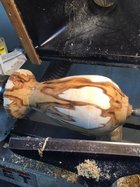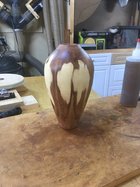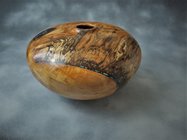I've read through a number of threads here about turning willow and got some good pointers. I've never turned it until today. I have a lot of it available due to a recent ice storm in our area that took out a big one in my neighborhood. I turned a couple of good vases out of it today (pic of rough shape attached) but was wondering about sealing and storing. Does it age well? Is it better to turn it now? I know some woods, and depending on when cut down, don't always age well. I have a good bit of maple out back that in a short time went almost black with mold so want to get as much out of this as I can. I like to let some of my stock age and spalt but not sure willow will age well. For hollow forms is it better to do like I normally do and once turn or is it a better candidate for twice turned forms?
-
It's time to cast your vote in the December 2025 Turning Challenge. (click here for details) -
Congratulations to Pat White for "Sicilian Mosaic" being selected as Turning of the Week for December 29, 2025 (click here for details) -
Welcome new registering member. Your username must be your real First and Last name (for example: John Doe). "Screen names" and "handles" are not allowed and your registration will be deleted if you don't use your real name. Also, do not use all caps nor all lower case.
You are using an out of date browser. It may not display this or other websites correctly.
You should upgrade or use an alternative browser.
You should upgrade or use an alternative browser.
Handling Willow
- Thread starter Randy Anderson
- Start date
I've done one black willow - it was the most volatile wood ever.
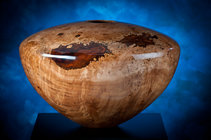
- It was dripping wet - was at the side of a pond when cut down
- It, and I, were smelling like a wet dogs during the first turning (and not one of those cute little fluffy ones)
- Spent a lot of time with the chain say before putting on lathe - got it rounded to a bit over 22" dia - best I recall, I left it maybe 1.5" wall thickness before boiling and then drying for over a year.
- Hollowing was difficult with the Munro cutter head - had to apply a lot of pressure to keep it from clogging
- Even with the thick wall, second turning was dicey - the end-grain area was less than 1/4" thick - was scared to go completely round with the second hollowing

John, mine turned fine and while very wet it didn't stink up the shop. I've had some logs that grew near wet soggy areas that literally would make the whole shop stink and had to let them air out for weeks before I could even try to sell. Hollowing was easier than most and able to clear out the stock inside but since my hollowing cutter head is essentially a scraper it doesn't leave a nice finish but no big deal. It's for flowers, not to look at inside. The outside work, like others have posted in other threads, does not tolerate scrapers of any kind at all. Even steep sheer cuts are a challenge. I've got enough available to try a few different approaches I think but don't believe I'll put boiling on the list of options.
- Joined
- Jul 18, 2018
- Messages
- 1,352
- Likes
- 2,932
- Location
- Baltimore, MD
- Website
- loujacobswoodturning.com
That’s a gorgeous turning John!
The weeping willow I turned was easier to turn when nearly dry. Mine was very bland, so didn't store anything long term.
My experience with Black Willow is that it is foolproof drying it without splitting or checking, I turned also a large Willow burl, and the separate burl twist I'll call them, did shrink and got splits around them, but the wood itself did not split at all, I had it sit in our house to dry for a couple years before I filled the splits with coffee ground and CA, it is still like that 
It turns just fine like any other softer wood, just watch the sanding, no course sandpaper as it will tear the wood, no bad smell that I remember either.
And no scraper use on it either
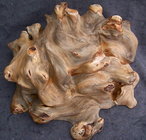
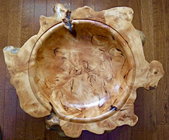
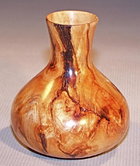
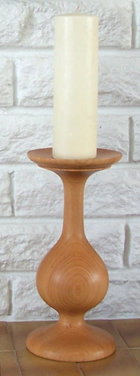
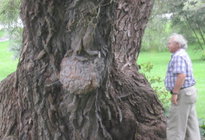
It turns just fine like any other softer wood, just watch the sanding, no course sandpaper as it will tear the wood, no bad smell that I remember either.
And no scraper use on it either





Last edited:
How old is/was that willow?
Charlie, if you're asking me I have no idea. It's the biggest willow I've ever seen. It's about 34" dia at the base.
I don't believe willow will spalt. Left on the ground, it will sprout and try to make a new willow tree. I'd say, rough it or turn it finished soon. It tends to crack around knots as it dries, if I remember correctly.
Assuming it doesn't age well I'm working through what I cut already. So far it's as some of you described - very wet, no scrapers at all, not even a neg rake scraper and requires sharp tools. I've been surprised at how quickly it will dull my gouges. I usually rely a lot on my scrapers to tune the final shape and form of my hollow forms and vases so it's really put my gouge skills to the test. I've found a sharp 1/2" spindle gouge to be my best weapon and even then knowing I don't have a scraper as a final step I have to really pay attention. Hollowing is a slow chore at first with no room for the wet sticky chips and sometimes have to dig them out since they get packed around the inside wall quickly. Not uncommon on wet wood but on willow they just stick and clump until I can slowly work enough open space for them to get out of the way so I can proceed. I'm hoping it dries well since the color and look has good potential.
Willow is a good teacher. I recall reading that willow often contains a lot of silica and tends to dull tools faster than you would expect based on how soft it is. It sure can be pretty, though.
You can always make a few wooden clogs!
Update and question for experience willow turners. My pieces, like the vase in my last post, sold and other vases have been popular. I turned a couple of bowls but not sure I'll do more. Vases seem to be doing better for me lately and these have such a different look.
Question - I've found that walnut oil takes a VERY long time to cure on willow. I know it can cure quickly on some woods and take a bit longer on others but willow seems to just not want to cure right for me compared to other woods. I had a similar experience with poplar once and wonder if there is something about willow that keeps it from curing correctly. Yes, I know warmth and UV light is needed but dang, it takes much longer than anything else I work with. Thinking on future pieces I try wipe on poly or danish oil.
Question - I've found that walnut oil takes a VERY long time to cure on willow. I know it can cure quickly on some woods and take a bit longer on others but willow seems to just not want to cure right for me compared to other woods. I had a similar experience with poplar once and wonder if there is something about willow that keeps it from curing correctly. Yes, I know warmth and UV light is needed but dang, it takes much longer than anything else I work with. Thinking on future pieces I try wipe on poly or danish oil.
I have also found that the amount of walnut oil affects curing time, a thick coat taking much longer. I wonder if the you ended up with a thick coat because the willow soaked up so much oil
Willow is one of the fastest growing trees. That tree could be only 30 years old.Charlie, if you're asking me I have no idea. It's the biggest willow I've ever seen. It's about 34" dia at the base.
Willow really soaks up the finish, so I think Michael has the answer. On a related noted, it seems to me that an oil finish ends up a little dull on willow. Maybe you'll get a result you like better than oil with poly or Danish oil.
Randy, Walnut oil barely hardens at all, and thick layer will have you notice this better.
I have years ago found that Polymerized Tung Oil works better than any of the other oils, and I dislike any of the on top finishes.
So I wipe on the oil and wait 10 minutes or so and wipe off the surface, let the oil polymerize for at least overnight and wipe on another layer of oil, again I will let it cure/polymerize, by then I will know if it needs more finish or not, depending the gloss I like.
After a month or two I will polish the finish, and that's it, finished.
I have years ago found that Polymerized Tung Oil works better than any of the other oils, and I dislike any of the on top finishes.
So I wipe on the oil and wait 10 minutes or so and wipe off the surface, let the oil polymerize for at least overnight and wipe on another layer of oil, again I will let it cure/polymerize, by then I will know if it needs more finish or not, depending the gloss I like.
After a month or two I will polish the finish, and that's it, finished.
Thanks all. I think I'll go with danish oil on the next pieces and see if it does better. I don't soak my pieces when applying oil but maybe willow can only handle a little dab. Something tells me it's more than the amount and has something to do with the wood itself.
Leo, not a top finish fan either. I want them to look and feel like wood.
Michael, good to know willow will spalt. I haven't been able to get to it as quickly as I hoped so will see.
Leo, not a top finish fan either. I want them to look and feel like wood.
Michael, good to know willow will spalt. I haven't been able to get to it as quickly as I hoped so will see.

